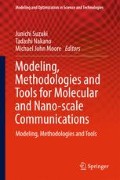Abstract
This chapter focuses upon the use of coding and protocols within diffusion based molecular communication systems, laying the groundwork for future development in test bed implementations. The chapter starts with an introduction that briefly discusses coding and protocols used in traditional communication systems. Following this, details of the molecular channel are given, including the energy consumption constraints and a relevant mathematical framework. This discussion then leads onto potential encoding and decoding technologies. Next, original results on the use of Hamming codes in molecular communication systems are presented with a quantitative comparison against an uncoded molecular system. The impact of specific design parameters such as the number of molecules, energy, and transmission distance on the bit error rate (BER) is considered. Finally, a protocol, based upon the use of an acknowledgement (ACK) packet is presented as a further advancement to the field that the reader may wish to consider when designing future systems.
Access this chapter
Tax calculation will be finalised at checkout
Purchases are for personal use only
References
Akyildiz IF, Brunetti F, Blázquez C (2008) Nanonetworks: a new communication paradigm. Comput Netw 52:2260–2279
Moore M, Enomoto A, Nakano T, Egashira R, Suda T, Kayasuga A et al (2006) A design of a molecular communication system for nanomachines using molecular motors. In: IEEE international conference on pervasive computing and communications workshops, pp 554–559
Bernard S (1988) Digital communications: fundamentals and applications. Prentice-Hall
Kurose JF (2005) Computer networking: a top-down approach featuring the Internet. Pearson
Moeneclaey M, Bruneel H (1984) Efficient ARQ scheme for high error rate channels. Electron Lett 20:986–987
De Munnynck M, Lootens A, Wittevrongel S, Bruneel H (2002) Transmitter buffer behaviour of stop-and-wait ARQ schemes with repeated transmissions. In: IEE proceedings in communications, pp 13–17
Kuran MŞ, Yilmaz HB, Tugcu T, Özerman B (2010) Energy model for communication via diffusion in nanonetworks. Nano Commun Netw 1:86–95
Leeson MS (2000) Performance analysis of direct detection spectrally sliced receivers using Fabry-Perot filters. J Lightwave Technol 18:13–25
Ziff RM, Majumdar SN, Comtet A (2009) Capture of particles undergoing discrete random walks. J Chem Phys 130. 27 Mar 2009
Kuran MS, Yilmaz HB, Tugcu T, Akyildiz IF (2011) Modulation techniques for communication via diffusion in nanonetworks. In: IEEE International Conference on Communications (ICC), pp 1–5
Kim N-R, Chae C-B (2012) Novel modulation techniques using isomers as messenger molecules for molecular communication via diffusion. In: IEEE International Conference on Communications (ICC), pp 6146–6150
Freitas RA (1999) Nanomedicine, volume I: basic capabilities. Landes Bioscience
Giné LP, Akyildiz IF (2009) Molecular communication options for long range nanonetworks. Comput Netw 53:2753–2766
Shannon CE (1948) A mathematical theory of communication. Bell Syst Tech J 27:379–423
Yan H, Choe HS, Nam S, Hu Y, Das S, Klemic JF et al (2011) Programmable nanowire circuits for nanoprocessors. Nature 470:240–244
Knowles JR (1980) Enzyme-catalyzed phosphoryl transfer reactions. Annu Rev Biochem 49:877–919
Sauro HM, Kholodenko BN (2004) Quantitative analysis of signaling networks. Prog Biophys Mol Biol 86:5–43
Leeson MS, Higgins MD (2012) Forward error correction for molecular communications. Nano Commun Networks 3:161–167
Blahut RE (2003) Algebraic codes for data transmission. Cambridge University Press
Howard SL, Schlegel C, Iniewski K (2006) Error control coding in low-power wireless sensor networks: when is ECC energy-efficient? EURASIP J Wireless Commun Networking 2006
Akyildiz IF, Fekri F, Sivakumar R, Forest CR, Hammer BK (2012) Monaco: fundamentals of molecular nano-communication networks. IEEE Trans Wireless Commun 19:12–18
Walsh F, Balasubramaniam S, Botvich D, Donnelly W, Sergeyev S (2007) Development of molecular based communication protocols for nanomachines. Presented at the proceedings of the 2nd international conference on nano-networks, Catania, Italy
Krivan V, Lánský P, Rospars JP (2002) Coding of periodic pulse stimulation in chemoreceptors. BioSystems 67:121–128
Atakan B, Akan O (2007) An information theoretical approach for molecular communication. In: Bio-inspired models of network, information and computing systems, pp 33–40
Author information
Authors and Affiliations
Corresponding author
Editor information
Editors and Affiliations
Rights and permissions
Copyright information
© 2017 Springer International Publishing AG
About this chapter
Cite this chapter
Leeson, M.S., Higgins, M.D., Bai, C., Lu, Y., Wang, X., Yu, R. (2017). The Use of Coding and Protocols Within Molecular Communication Systems. In: Suzuki, J., Nakano, T., Moore, M. (eds) Modeling, Methodologies and Tools for Molecular and Nano-scale Communications. Modeling and Optimization in Science and Technologies, vol 9. Springer, Cham. https://doi.org/10.1007/978-3-319-50688-3_6
Download citation
DOI: https://doi.org/10.1007/978-3-319-50688-3_6
Published:
Publisher Name: Springer, Cham
Print ISBN: 978-3-319-50686-9
Online ISBN: 978-3-319-50688-3
eBook Packages: EngineeringEngineering (R0)

